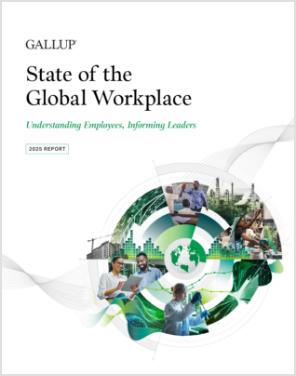Story Highlights
- Engagement declined in the U.S. and Canada and rose in South Asia
- Europe has the lowest employee engagement globally
- Stress is higher in younger workers and exclusively remote and hybrid workers
There’s good and bad news for employees globally: They’re more engaged at work but also feel more stress.
First, the good news: The percentage of engaged employees globally rose from 2021 to 2022. With a temporary drop in engagement in 2020, the trend since Gallup has been reporting the global metric in 2009 has been on a steady incline. Starting as low as 12%, the percentage of engaged full- and part-time employees working for an employer has risen to 23%. This gain of 11 percentage points represents an increase of more than 250 million engaged employees in the global workforce.
With the only representative sampling of the world’s workforce, Gallup has surveyed 2.2 million employees since 2009 -- approximately 160,000 per year.
Gallup measures and tracks global employee engagement because it has significant linkages to many performance outcomes that organizations care about, including customer loyalty, employee retention and productivity. Gallup has published 10 iterations of its meta-analysis during major changes in the economy and technology. The ties to performance have been strong throughout these changing circumstances. Employee engagement has an even stronger connection to performance outcomes during tough economic times.
Looking at the bigger picture, employees who are not engaged at work or actively disengaged represent an $8.8 trillion untapped productivity opportunity for global workplaces.
While less than one-fourth of employees are engaged at work, many organizations have tripled that rate, or more. Gallup Exceptional Workplace Award winners average more than 70% of engaged workers. These organizations operate in varied geographies and industries and are of different sizes. But they have achieved strong workplace cultures regardless of these differences.
Notable findings about engagement:
- Regions with the highest levels of employee engagement are South Asia (33%), the United States and Canada (31%), and Latin America and the Caribbean (31%). The global rise in employee engagement was due to increases in South Asia and Latin America and the Caribbean. Engagement levels in the U.S. and Canada have recently declined.
- The European region has the lowest employee engagement (13%).
- Globally, 31% of managers are engaged, compared with 20% of individual contributors.
- Exclusively remote employees (30%) are more engaged than fully on-site (21%) and hybrid (24%) employees.
Global Stress Maintains a Record High
While employee engagement has been on the rise, the bad news is that employee stress has also increased. Stress is associated with physical and mental health problems and lower productivity. This raise in employee stress emphasizes the importance of organizations simultaneously addressing employee engagement and wellbeing in the current and future workforce.
Notable findings about employee stress:
- While the U.S. and Canada are among the most engaged workers in the world, 52% of workers reported stress a lot of the day yesterday. In contrast, only 13% of Europeans are engaged but reported stress is lower, at 39%.
- Stress is also high in East Asia (52%), a region with low employee engagement (17%).
- Stress is higher globally among young workers and those in exclusively remote or hybrid work locations.
More Key Findings
- More than half of employees (59%) are quiet quitting (not engaged), and 18% are loud quitting (actively disengaged). Quiet quitting employees cite issues related to employee engagement or culture, pay and benefits, or wellbeing as areas they would change about their workplace to make it better.
- More than half (51%) of global employees working for an employer are actively looking for another job or watching for openings. Actively disengaged employees are 42% more likely to be actively looking or watching for openings in comparison to engaged employees.
- While exclusively remote and hybrid employees report higher employee engagement, they also report higher stress -- perhaps caused by a less predictable or structured work life. But employee engagement has 3.8 times as much influence on employee stress as work location. In other words, what people are experiencing in their everyday work -- their feelings of involvement and enthusiasm -- matters more in reducing stress than where they are doing their work. No location can fix poor management.
- Gallup has found that effective management in the more remote and hybrid, post-pandemic workforce involves having one meaningful conversation with each employee once per week that focuses on recognition, collaboration, goals and priorities, and strengths. These feedback meetings can be short (15-30 minutes) if they happen weekly.
Consider the level of engagement among the world’s best-run organizations (72%) and what it could mean for organizations and society if their organizational practices were widespread: record high productivity, customer retention and growth, better employee retention, and significantly reduced stress.




